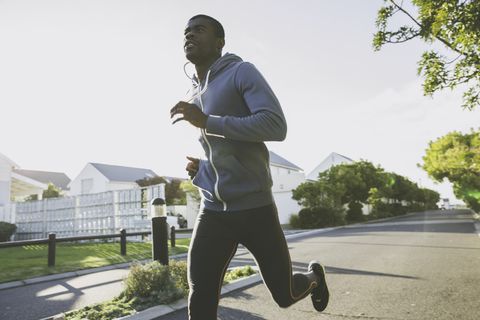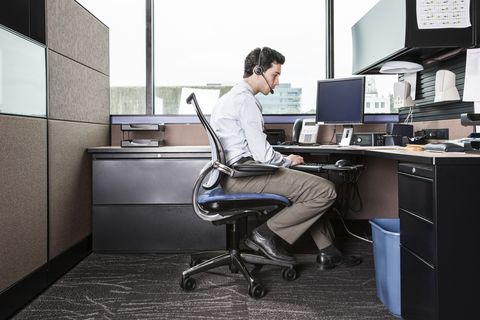Do you ever see guys squatting, deadlifting, and jumping around the gym and think that there’s no way your inflexible self could come close to repeating the moves? You’re not alone. A Reddit thread highlighted a problem lots of guys face when they’re looking to get active: stiff hips.
But the problem isn’t just reserved for the gym. A recent review presented at the American Academy of Orthopedic Surgeons annual meeting revealed that the number of men under the age of 65 who undergo hip surgery is on the rise, and another study out of Sweden recently revealed that patients suffering from osteoarthritis who receive hip replacements tend to live longer due to an improved quality of life.
Of course, if your hips are healthy to begin with, you’ll experience less pain and even lower your chances of injury. The key is to keep them moving properly. “Tight hips can lead to compensatory patterns, which lead to muscle imbalances,” explains Chicago-based physical therapist David Reavy, PT, OCS. “A tight muscle will not allow you to produce the same amount of force—nor absorb it.”
San Francisco-based trainer and mobility specialist Nat Viranond, NASM-CPT, FRCM, created three hip flows designed to mobilize the joints based on the ways (and movement patterns) you might use them most: running, strength training or… sitting at your desk. All of the movements are geared toward improving the hips’ ROM while activating and strengthening surrounding muscles to help control the movement.
“Joints need to be strong enough to handle repetitive stress,” Viranond says. “If you can’t flex your hip when you sweat, for example, that movement and flexion will come from somewhere else in your body, potentially causing an injury.”
Perform the following flows before a workout or run as a warm-up, or if you wish to focus more on flexibility, perform the flows post-training when your blood is already flowing. Viranond recommends doing at least one set of Controlled Articular Rotations (CARs) daily, and an entire flow two to three times per week.
The Hip Flows
For Runners

Hero CreativeGetty Images
Standing Hip CAR
What it does: Helps to gently bring circulation to all tissues in and around the hip joint, and provides a baseline of your overall hip mobility. These standing CARs mimic the hip flexion needing for running.
How to do it: Stand and hold a chair or wall with your right hand, if necessary for balance. Keeping your core pulled tight, lift your left knee, and with your body still, open that knee to the left side. Circle the knee so that your foot comes behind you, until your left knee meets your right. Perform three to five reps, and then circle in the other direction while squeezing your glutes for three to five reps. Switch sides and repeat.
Standing Hip Stretch
What it does: Stretches the front of the thigh while activating muscles along the backside of the body, and helps teach your body to control hip ROM.
How to do it: Stand with feet slightly wider than hip-distance, and take a large step back with your right foot. Pretend you’re wearing a belt, and aim to point the buckle toward the ceiling with your pelvis. Bend your left knee while keeping your back leg straight, like a deep lunge. Hold for at least five deep breaths, and create isomeric tension within your glutes and core. Slowly release the contraction and repeat on the other side.
Hip Capsule Sleeper Stretch
What it does: Works internal rotation—an area in which athletes tend to lack mobility. When hips can’t internally rotate, the impact from running can lead to hip and back pain.
How to do it: Sit with knees bent to 90 degrees, and feet slightly wider than hip-distance. Bring the inside of your right knee toward the floor, and gently deepen the stretch with your right hand, while maintaining 90-degree angles in the knee and ankle. Hold for up to two minutes. Next, press the knee into the hand, to create an isometric contraction. Hold for five breaths. Switch sides and repeat. Repeat the contraction cycle three times in each direction on both sides
For Desk Jockeys

Mint ImagesGetty Images
Hula Hip CAR
What it does: Helps undo tightness and reduced ROM caused by excessive sitting. Like other CARs, these help the hips move through their entire range of motion while remaining gentle on the joint.
How to do it: Stand with feet about hip-distance, and perform a hula hoop circle with your hips. Bend at the waist as needed, to create as large a circle as possible while maintaining muscular control. Contract your glutes when your torso tilts behind you. Perform 10 circles in each direction.
Half Kneeling Hip Flexor Stretch
What it does: Stretches hip flexors (to undo ‘sitting-position’ tightness) while engaging the hip extensors, to control increased ROM.
How to do it: Kneel with your left foot on the floor and right knee down (like a knight), and move your right knee slightly out to the side. Contract your glutes so that your imaginary belt buckle points toward the ceiling. Shift your weight forward and feel a stretch along the front of your right hip. Once the stretch begins to dissipate, create an isometric contraction by pulling the knee slightly against the floor. Hold for five breaths and push toward the back of the room, for five more. Switch sides and repeat.
Seated Hip Flexion
What it does: Stretches the entire hip area while allowing you to remain seated at your desk.
How to do it: Sit and pull one knee toward your chest into a gentle stretch. Hold for three breaths and begin to push your knee forward into your hands creating an isometric contraction. Next, aim to pull your thigh and torso toward each other without using your hands. Repeat the contraction cycle for three to five reps.
For Strength Trainers and CrossFitters

Erik IsaksonGetty Images
Quadruped Hip CARs
What it does: Performing this move on all fours helps signal the body to stabilize the core—something that happens with every strength move. (When you remove a support base, you’ll activate your core to stabilize your body.) Several strength moves also take place in a prone position.
How to do it: Get on all fours, with your right side next to a wall. Pretend there is a cup of hot coffee sitting on your back, and slowly pull your left knee toward your left elbow, and then swing it out and up toward the ceiling. Slide the leg back around, rotating your thigh and pointing your knee toward the floor. Perform three to five circles. Next, reverse the movement, and slowly push your heel toward the ceiling. Bring your knee toward your left elbow as you return to start. Perform three to five more reps, and switch sides.
Kinetic Frog Stretch
What it does: Grooms hips for deep squats and repetitive squats—helping to protect them from overuse injuries.
How to do it: Get on all fours and start to sit back, keeping your knees wide apart and lowering your glutes toward your heels. This time, your belt buckle should point toward the floor. Allow your torso to sink toward the floor while pulling knees farther apart, if possible. Hold for up to two minutes. Next, drive both knees into the floor, to create an isometric contraction. Hold for five breaths. Pull knees in the opposite direction, to create another isometric contraction for five more breaths. Finish by contracting your glutes, so your imaginary belt buckle points toward the ceiling. Hold for five breaths and release.
Standing Passive Flexion Hold
What it does: Teaches the body to control ROM for common strength moves like squats, lunges, and mountain climbers, to help protect the joint during repetitive movements.
How to do it: Stand and hold something for balance, if needed. Grab your right knee with your right hand, and pull it up toward your chest and squeeze for five breaths. Slowly release and lower, creating an isometric contraction against your hand for five more breaths. Perform five sets of contractions, switch sides, and repeat for five more.
Source: Read Full Article
